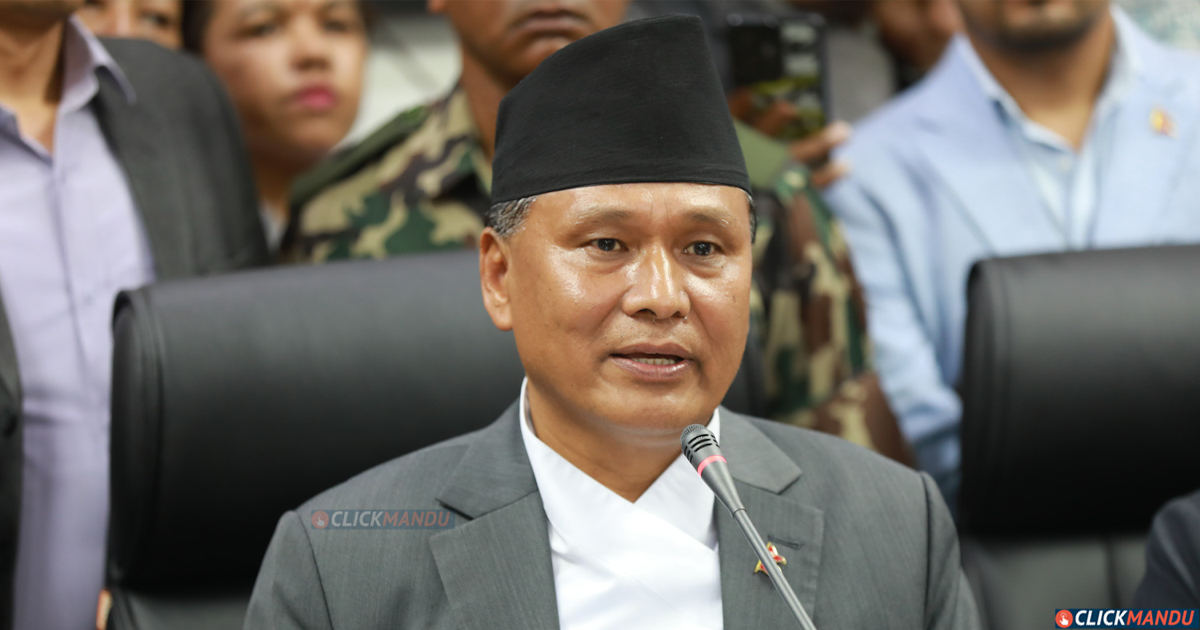Kathmandu: Minister for Energy, Water Resources and Irrigation, Kulman Ghising, has said that he is ready to be flexible to resolve the ongoing “dedicated and trunk line” electricity billing dispute.
He made the remark on Sunday during a discussion with acting president of the Federation of Nepalese Chambers of Commerce and Industry (FNCCI), Anjan Shrestha, and Director General Gokarna Awasthi.
“The discussion with Minister Ghising was very positive — the seven-year-long dispute seems to be moving toward resolution this time,” Shrestha told Clickmandu. “The Minister appeared serious about settling this issue.”
While serving as the Executive Director of the Nepal Electricity Authority (NEA), Ghising had taken a strict stance on this issue. However, businessmen say he now appears more responsible and open to dialogue since assuming the ministerial post.
On September 28, NEA issued a notice warning that power supply to industries would be cut off by October 19 if outstanding dues were not paid. Since then, industrialists have intensified lobbying efforts. They have also been trying to meet Prime Minister Sushila Karki and have sent her a collective letter while maintaining continuous dialogue with Minister Ghising.
“I want this dedicated and trunk line dispute resolved quickly. I am ready to be flexible and discuss possible solutions,” Minister Ghising was quoted as saying by FNCCI acting president Shrestha. “Now we, the business community, will sit together for further discussion — hopefully, a solution will come out of it.”
Shrestha maintained that cutting off electricity lines to industries would not solve the problem.
Ghising, as NEA chairperson, had formed a “review committee” under the Electricity Act and used it to exert pressure on industrialists.
What is the dedicated and trunk line dispute?
While heading NEA, Ghising imposed backdated electricity bills on industries using “dedicated” and “trunk” lines — special connections that ensured uninterrupted supply even during load-shedding. Industrialists argued that NEA added “premium charges” arbitrarily and demanded evidence that uninterrupted power had indeed been supplied as per the contract. NEA, however, has failed to produce such proof to date.
Ghising has claimed that over Rs 22 billion remains to be recovered under these charges.
Industrialists insist that premium fees should be paid only if electricity was supplied under the conditions set by the Electricity Tariff Fixation Commission. The then government led by Pushpa Kamal Dahal formed a committee under former justice Girish Chandra Lal Yadav to study the dispute. The committee recommended collecting dues based on “Time of the Day” (TOD) meter data, and the then Oli government instructed NEA to act accordingly — but implementation never happened.
Following NEA’s decision, industries deposited a 5 percent security amount in banks and filed for review before the NEA’s Review Committee, which holds the legal authority to decide whether such arrears are collectible. If dissatisfied with the committee’s decision, industries can appeal to the court — the proper legal process for resolving the dispute.
NEA had also allowed industries to pay in 56 installments. Many industries sought review under this facility, but the committee — coordinated by NEA board members — has yet to deliver a decision.
Courts have refused to issue stay orders to industries that bypassed the Review Committee. The 2016 Electricity Revenue Collection Regulation (Rule 5, Sub-rule 13) does not allow NEA to impose higher rates on “disputed bills.” Still, both sides must agree on a mutually beneficial rate to resolve the issue.
According to the 2012 NEA Distribution Regulation, the Review Committee must decide within 35 days of appeal. The High Court and Supreme Court have both indicated that the committee’s decision is a prerequisite for legal resolution.
Policy and legal background
Upon assuming office as Energy Minister on September 15 (Bhadra 30), Ghising signed his first decision — to recover arrears from dedicated and trunk line users. He later dissolved the NEA Review Committee entirely on September 26, which critics see as an attempt to pressure the process.
Many ordinary people believe the dispute is about industries not paying electricity bills. In truth, industries have been paying all regular bills on time; the dispute concerns only the premium rate — whether it applies or not.
NEA had regularly issued normal bills, and industries even availed a 2 percent discount for timely payment.
So how did arrears arise? The disagreement is not over how many units were consumed but over what rate should apply per unit.
Timeline of events
Load-shedding began in Nepal in 2005 as demand outpaced supply.
In 2012, the government decided to provide uninterrupted power to essential services like security agencies, hospitals, Singha Durbar, telecom, drinking water facilities, and airports.
NEA began supplying these through sub-stations with direct lines.
As losses grew during load-shedding, NEA introduced the concept of a premium charge for industries, businesses, and non-business customers receiving regular power.
On 26 June 2015, NEA’s board decided to impose extra charges from July 17 on customers receiving continuous electricity through dedicated feeders.
The Electricity Tariff Fixation Commission (ETFC) — the only body authorized to approve rates — later ruled that NEA could not impose extra charges without approval.
However, on 13 January 2016, the ETFC allowed NEA to levy a premium charge only for customers who actually received 24-hour continuous power. The Cabinet then approved this from February 2016. Thus, the first phase of dispute (July 2015–January 2016) was settled by Cabinet decision.
The current dispute concerns bills from February 2016 to April 2018: whether industries should pay premium rates during this period, depending on whether uninterrupted power was actually supplied.
Since load-shedding ended in April 2018, NEA agrees that premium charges do not apply from May 2018 onward.
Industrialists argue that premium rates apply only if 24-hour uninterrupted supply was received from dedicated lines. They cite the ETFC’s 103rd meeting decision requiring NEA to prove that 24-hour service was provided before imposing premium charges.
Similarly, for trunk lines, the ETFC’s 108th meeting decided that customers receiving more than 20 hours of power per day during over 6 hours of load-shedding could be charged like dedicated users.
Industries are demanding that NEA produce TOD meter data proving they used electricity for more than 20 hours a day — NEA has failed to do so.
The billing controversy
Had NEA billed customers at premium rates from February 2016 (for dedicated) and July 2016 (for trunk lines), the issue could have been settled earlier. Instead, NEA sent the bills only in March 2019 — four years later — adding premium charges retroactively.
Industrialists claim they never used power for more than 20 hours a day and that NEA has no TOD data to disprove this. They argue that without meeting the ETFC’s conditions, premium charges are invalid.
Despite this, NEA issued “adjustment bills” in March 2019 under the 2016 Revenue Collection Regulation, which allows correction for consumption errors — not rate disputes.
Industries now say they are ready to pay if NEA provides evidence that uninterrupted power was supplied — as per ETFC’s conditions.
NEA, however, has billed Rs 6.6 billion (660 crore) for February 2016 to April 2018 without such proof.
Industrialists maintain that the dispute is not over electricity consumption but over which days and at what rate the premium applies.



Comment Here